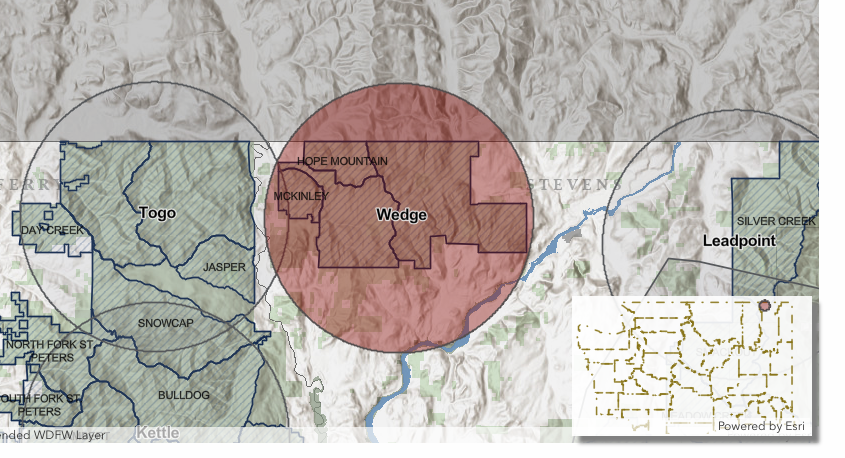
1 Wedge Wolf Removed; More Depredations Beforehand Reported
A Northeast Washington wolf was lethally removed by WDFW today and its pack, the Wedge wolves, is believed to have been responsible for two more livestock depredations not long beforehand.

WDFW says it is now in an evaluation period with the far northern Stevens County pack but could go back in if there are more attacks on livestock.
The Wedge wolves are blamed for killing three cattle and injuring 11 more, two more head than as of last Thursday morning when Director Kelly Susewind decided to go lethal after “proactive and responsive non-lethal deterrents used by the affected livestock producers in the area this grazing season” failed to stem depredations that began in May.
The wolf that was removed was described as a nonbreeding female.
The pack was believed to include three adults and possibly juveniles, though that was not confirmed by WDFW.
Last week, immediately after the agency announced Susewind’s decision to remove one Wedge wolf, out-of-state advocates made good on their threat to go to Governor Inslee to request he reverse the Fish and Wildlife Commission’s unanimous late June rejection of their petition to codify nonlethal tactics be used to reduce wolf-livestock conflicts.
Earlier today WDFW issued a statement on that. It reads:
The Washington Department of Fish and Wildlife (WDFW) has invested an extensive amount of time building a robust engagement program that has been recognized for its approach to consensus building. The Department always welcomes feedback on our programs but believes the current wolf-livestock interaction protocol process allows us to consider each situation and weigh the specifics of each depredation case to determine if lethal removal is an option. Reworking this process could result in blanket criteria that doesn’t have the flexibility to consider individual factors.
Our process is a responsible and reasonable approach that provides a responsive way to meet the needs of our residents and wildlife that rely on us.
Groups such as Center for Biological Diversity of Arizona and Cascadia Wildlands of Oregon, among others, are trying to insert themselves in Washington wolf management and are using any and all means to do so.
Their petition called for “enforceable constraints on when, where and how lethal removal may occur,” but members the Fish and Wildlife Commission rejected that approach as too shackling.
Removals are guided by WDFW’s 2017 Wolf-Livestock Protocols, developed with Wolf Advisory Group stakeholders – instate representatives of the livestock, hunting and conservation worlds.
They stress preventing conflict through range riding, delayed turnout, moving sick or dead cattle off the range and other measures first but allow for WDFW’s director to consider taking out wolves in packs that commit three rapid-fire depredations or chronically kill cattle, sheep or other domestic animals over a 10-month window in an effort to head off further losses for both herds and packs.
Yet this part of the state has also seen years of wolf-cattle conflicts, and opponents of WDFW’s removals will point to a couple dozen previous wolves taken out after attacks on one rancher’s calves and cows. Even instate organizations that have been supportive of the state in the past are beginning to chafe at “five consecutive years of cattle loss and wolf killing,” and say “the status quo simply can’t continue in the northern Kettle Range without serious social and political fallout.”
Still, last week saw WDFW win a court case in King County where a judge affirmed a kill order last summer and that the protocols did not need to have undergone lengthy State Environmental Policy Act review.
Last week also saw news that the agency had suspended its monthlong hunt not far to the west for up to two Togo Pack wolves without success, though no cattle had been depredated on during that period either.
